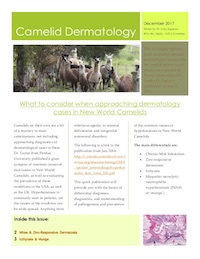Camelids on their own are a bit of a mystery to most veterinarians, not including approaching diagnostics of dermatological cases in them.
Here is the publication from January 2014 (PDF)
This quick publication will provide you with the basics of differential diagnoses, diagnostics, and understanding of pathogenesis and prevalence of the common causes of hyperkeratosis in New World Camelids.
The main differentials are:
- Chronic Mite Infestation
- Zinc-responsive dermatosis
Icthyosis - Idiopathic necrolytic
neutrophillic hyperkeatosis (INNH or ‘munge’)
Zinc-responsive Dermatosis
Also termed ‘idiopathic hyperkeratosis,’ tends to affect younger stock (1-2 years of age), and a predisposition to coloured fleece compared to white fleece. The name of idiopathic (unknown cause), is due to this form dermatosis possibly caused by a true deficiency of zinc, or coincidence of responding to therapies of high-dose zinc.
If this is a likely differential, there will generally only be a single animal affected in the herd. It is likely to be a younger breeding female, and generally of darker fleece, both due to increased demands on mineral metabolism, as well as higher levels of zinc and copper in darker fleeces.
Diagnosis should take form in serum Zn levels, and histopathology (NB: Normal serum Zn does not rule out this condition). Suggestive findings in histology should reveal mild-moderate dermatitis with lymphocytes, macrophages, plasma cells and occasional eosinophils; coupled with epidermal and follicular
It was found that the most common mite infestation of camelids in the USA, is chorioptic mange, specifically Chorioptes
Diagnosis of mites can be complex in camelids, as with other species. Skin scrapings should be used to try and find mites present to identify which mite is causing the problem for appropriate treatment to be given. Studies have shown that with C.
Biopsy with histopathology can be used to aid in diagnosis, with possible mite visualization. Eosinophilia is a common finding, and
Munge
Munge, or
Ichthyosis
A congenital disorder, either present at birth or in the first early days. The lesions can be either focal or diffuse lesions of hyperkeratosis or scaling. There is a genetic abnormality leading to inadequate sloughing of skin cells in the upper layers of the epidermis leading to an increase in skin thickness.
Two forms are recorded in other species, and it seems a full understanding within camelids is yet to be understood, but similarities would still exist. The less common form in other species
Key Points for differentials
Signalment:
- Young adults (1-2 years): Zinc-responsive dermatosis or INNH
- At Birth: Ichthyosis
- Any age: Mites
Biopsy
+ Histopathology:
- Eosinophilia: Mites
- Inflammatory Cells Present: Zinc-responsive dermatosis
- Lack of Inflammatory Cells: Ichthyosis
- Epidermal oedema and keratinocyte necrosis:
INNH

